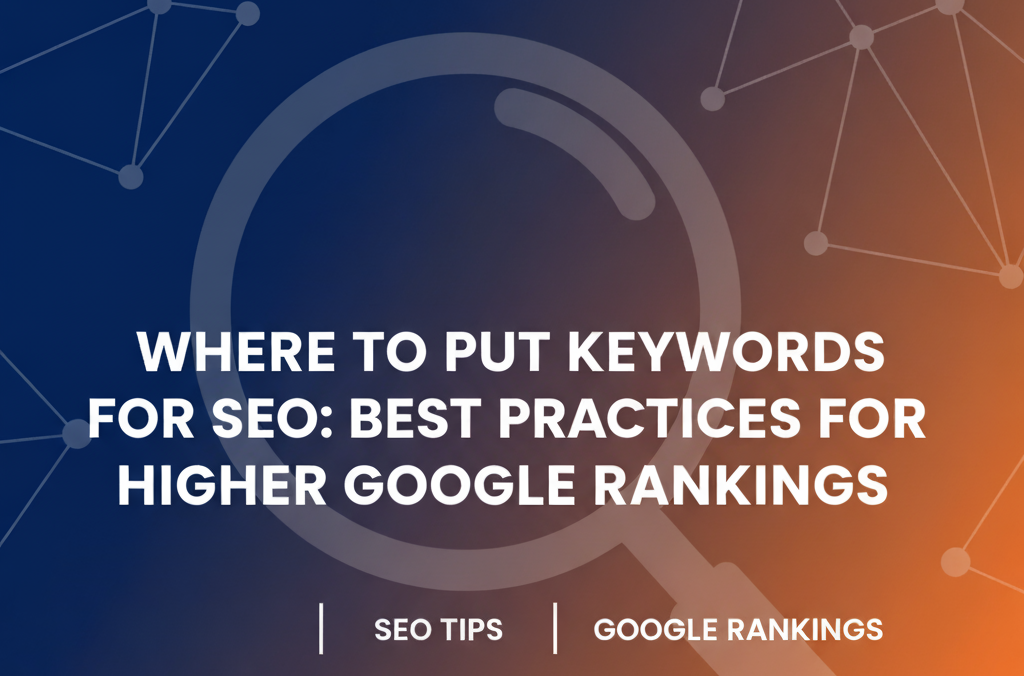In the world of digital marketing as well as SEO or search engines (SEO) Keywords are a crucial factor in aiding search engines to understand the content you’re writing about. But, just picking the correct keywords isn’t enough. It is more important understanding which keywords to place in order to improve SEO so that you can maximize results in search and boost your ranking on Google. When you’re optimizing content for blogs and service pages or eCommerce article content, proper positioning of keywords will significantly impact the performance of your website.
Let it Break down that “Where to Put Keywords for SEO”?
This comprehensive guide will help you determine the most effective places to incorporate keywords effectively and naturally aiding you in improving your click-through rate, improve the amount of traffic to your site, and increase its quality.
Table of Contents
ToggleWhat Is Keyword Placement in SEO?
Keyword placement is defined as the deliberate placement of pertinent search terms in specific parts of your site so that it can tell Google the content of your page. about. If done properly keywords placement will help search engines to properly search for your site’s content and match your content with the intent of users. Additionally, it improves the readability of your content. makes sure that your content is relevant to the current time, as well as improves your website’s SEO.
Why Keyword Placement Impacts Rankings
Google and other search engines like Google browse through thousands of websites each day, in search of the patterns of keywords, their relevance to search results pages structure, keywords, and quality of content. The keywords you choose to place are an outline that aids search engines classify your contents, increasing your chances to be ranked for specific phrases in search results. A poor or infrequent placement of keywords On the other hand they can create confusion in search engine algorithms which can result in a decrease in rankings and even penalization due to keywords that are stuffed with.
For higher ranking to be more prominent, you should put your keywords in the areas that have the greatest weight and relevancy without compromising user experience.
Where to Put Keywords for SEO: Top Strategic Areas
Here are the best places to place your keywords for primary and secondary:
1. Page Title (Title Tag)
Titles of pages are one of the top rankings signals. The search engines rely on it to recognize your page’s content. Moreover, people see it in search results pages (SERPs).
Recommended Practice: Incorporate your keyword at the end of your title in order to boost your visibility.
Example:
Where to Put Keywords for SEO: Best Practices for Higher Google Rankings
2. URL (Permalink)
Google prefers clear, concise descriptive URLs. Incorporating your keywords in the URL will improve the ranking signal and increase trust among users.
Example:
www.yourwebsite.com/where-to-put-keywords-for-seo
3. Meta Description
While meta descriptions aren’t an element of ranking, they affect click-through rate. The inclusion of your keywords helps assure people that your site is of interest.
Meta Description Example:
Wondering what keywords to use for SEO? Learn the top ways to place keywords in order to increase your Google ranking and to optimize your contents effectively.
4. First Paragraph or Introduction
The search engines look at the opening paragraph to swiftly identify the content’s relevance. When you place your primary keyword in the initial 100-150 words, it helps identify the content early.
5. Headings (H1, H2, H3)
Utilizing keywords in headings does not just improves SEO, but creates a proper hierarchy of content. Your H1 tag should include the primary keyword. H2 and H3 tags may include long-tail and variations of your keyword.
Example Headings:
H1: Where to Put Keywords for SEO
H2: Why Keyword Placement Matters
H3: Best Keyword Placement Techniques
6. Body Content
The keyword you choose to use should be used several times in the text However, only when it is appropriate. Google prioritizes relevance to context and user experience. Therefore, do not use repetitive keywords that are unnatural.
The Ideal Density is Around 1% up to 1.5 percent, however readingability is more crucial than achieving the percentage you want to hit.
7. Image File Names and Alt Text
Images are an under-appreciated SEO benefit. The search engines are unable to interpret images thus they depend on alt texts for the context. This is also a way to make it easier to visually impaired people.
Example:
File name: keyword-placement-guide.jpg
Alt text: illustration showing where to put keywords for SEO
8. Anchor Text (Internal and External Links)
When integrating other pages of your site Use anchor texts that are keyword rich rather than generic words such as “click here.” This aids in establishing contextual relevancy and enhances the structure of your site.
9. Subheadings and Bullet Points
The inclusion of keywords in subheadings, or bullet points could help to increase clarity and help highlight key concepts that search engines are prone to recognize.
10. Conclusion Section
Incorporating your information by incorporating a keyword, or its variant strengthens your content and indicates fullness. It also increases the likelihood of semantic relevancy.
Where Not to Place Keywords
Each part of your website’s content requires the use of keywords. The overuse of keywords can lead to keyword stuffing and could cause penalizations.
Beware of using keywords
In every sentence, it is repeated.
Random positions that do not seem to
In alt text for images, in instances where it isn’t applicable
Internal links don’t matter
Always remember that clearness and natural flow always top the list.
Keyword Placement Checklist
| Placement Area | Importance Level | Goal |
|---|---|---|
| Title Tag | High | The topic should be defined clearly. |
| URL Slug | High | Improve the quality of your content |
| Meta Description | Medium | Improve CTR |
| Introduction | High | Verify the relevance as early as possible. |
| Headings (H1/H2/H3) | Medium | Structure Content semantically |
| Body Content | High | Be aware of your surroundings |
| Image Alt Text | Medium | Assist with SEO and accessibility |
| Anchor Text | Medium | Increase the relevancy of links |
| Conclusion | Medium | Reinforce topic |
SEO Tools to Help in the Placement of Keywords
Numerous tools such as Yoast SEO, Rank Math as well as All in One SEO provide actual-time recommendations on the placement of keywords. Services for optimizing content such as BoostRankify can also provide expert site-wide audits that ensure the distribution of your keywords is in line with the guidelines for ranking.
FAQs
1. How many times can I include my key word in my article?
There’s no set standard, however a word density of 1 to 1.5 percent is usually acceptable. Be sure to focus on the usage that is natural and readability, rather than repeatedly repeating the same phrase.
2. Do you need to put the word “keyword” in each section?
It is not necessary, but the H1 tag should contain the primary keyword. Subheadings may include synonyms or other terms that are related to enhance semantic design.
3. How can I rank if I don’t have perfect positioning of the keywords?
The correct keywords can significantly increase the chances of being ranked higher and quicker. It assists Google to understand your subject and also improves users’ experience.
Final Thoughts
Knowing where you should place keywords in order to improve SEO will dramatically increase the chances of being ranked higher for search engines. From including them within the title tag and URL, to making them more strategically used in the meta description, headings, and alt text, the placement of keywords remains an important element of SEO that is on-page. The aim is to keep the natural reading experience while signalling relevancy to search engines.
If you need help with optimizing your contents to increase the distribution of keywords and performance in ranking, solutions such as BoostRankify assist businesses in improving the SEO structure of their websites, enhance the relevance of keywords, as well as increase general visibility.






